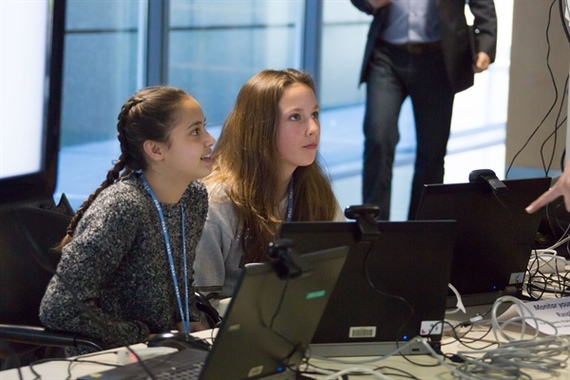By Marcelo Cabrol

Marcelo Cabrol is the manager of all external communications for the Inter-American Development Bank Group. His portfolio includes Demand Solutions, a business model that applies entrepreneurial thinking to solving persistent development problems in fields such as health, transportation, and energy.
Coding is basic literacy for the Fourth Industrial Revolution. It is an integral part of the digital age, which in turn has ushered in that revolution. As popularized over the past year or so by the World Economic Forum and others, this revolution is based on the arrival of new, emerging technologies that are intersecting at exponential rates of speed and scale, dramatically increasing productivity and economic growth, and creating better jobs and entirely new industries. Code powers this digital world. Every website, smartphone app, computer program, calculator and even microwave oven relies on code to operate. This makes coders the architects and builders of the digital age.
So, what better way for Latin America and the Caribbean to be part of this revolution than by giving its children the tools that they need to be digital citizens? Other countries have already started. In the United States, Code.org is a non-profit committed to introducing American schoolchildren to coding. The United Kingdom has launched a new computer curriculum for kids as young as 5. Even developing countries are active in this endeavor: the Ghana Code Club wants to take coding to all Ghanaian children. It's a not-for-profit started by Ernestina Edem Appiah, a former administrative assistant who admired IT professionals and became a self-taught coder.
All these initiatives face a similar challenge: girls are underrepresented among their students. And this fact has spurred other ideas: girlswhocode and blackgirlscode, for example, have the shared mission to close the huge gender gap in technology in the United States. Achieving gender balance is important: knowledge of coding increases the numbers of girls in classes and schools dedicated to STEM--science, technology, engineering and math--allowing for a dramatic improvement in a nation's capacity to innovate and to improve productivity and equality.
Laboratoria: Coding for young women in Peru
This is where Peru's Laboratoria comes into play. Laboratoria, the brainchild of Mariana Costa, Herman Marin, and Rodulfo Prieto, was launched in 2013 as a "tech social enterprise that empowers young women by giving them access to education and work in the digital sector." Mariana and her team provide hands-on training to women who could not enroll in a university because of lack of income, or responsibilities as young mothers.
Laboratoria's business model is simple but effective: after a meticulous selection process, it provides beneficiaries with two months of training in mathematics and programming aimed directly at placement in companies demanding those skills. More than 70 percent of Laboratoria graduates are employed after completing their course. This success rate is explained not only by the quality of the training, but also by Laboratoria's many partnerships with private companies, including Google and Peruvian businesses Telefonica - Perú and Liderman, one of the biggest private security companies in the country. [Full disclosure: the Inter-American Development Bank is exploring the possibility of partnering with Laboratoria in an effort to scale up opportunities to provide training in coding.] Laboratoria also seeks sustainability: in addition to its educational component, it sells tech services to support itself.
Using this model, Laboratoria combined coding, inclusion, and employment for 130 young women last year. This sounds like a small number. But what would happen, for example, if the Peruvian government dared to adapt this model to its secondary schools throughout the country, benefiting all students, both girls and boys? The implied change in curriculum would be demanding--we all know the difficulties of scaling up small solutions in educational settings, but imagine the potential comparative advantages for the country's workforce and competitiveness. Furthermore, Laboratoria has expanded and now also operates in Mexico and Chile.
This idea of "democratizing" coding is no doubt a tall order. But it would also be inspiring: a local solution, oriented toward equitable outcomes and opportunities, propelled by a new cadre of entrepreneurs who are able to design and implement high value-added programs. Coming back to the requirements of the Fourth Industrial Revolution for Latin America and the Caribbean, countries like Peru face the challenge of preparing as many of their students as possible to be digital citizens, thereby improving their employability and promoting educational inclusion. The ability to join the revolution and benefit from it, and to meet many other emerging challenges, can come from Laboratoria and other unexpected places.
From the Multilateral Investment Fund Trends blog
